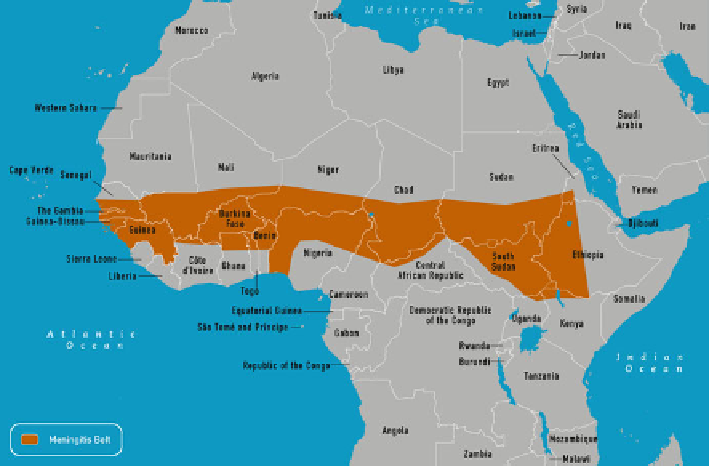Geoscience Reference
In-Depth Information
Fig. 15.3
Map identifying high prevalence areas of meningitis in Africa (Source: Center for
Disease Control and Prevention)
15.5.2
Meningitis
Meningococcal meningitis is a serious infection of the meninges, the membrane
lining that surrounds the brain and spinal cord. Caused by bacteria, it can result
in brain damage or, if untreated, death in 50 % of cases (WHO
2012b
).
Neisseria
meningitidis
is the bacteria usually responsible for epidemics, though other bacteria
(i.e.,
Streptococcus pneumonia
and
Haemophilus influenzae
) may also cause menin-
gitis (WHO
2012b
). The bacteria, spread by respiratory secretions, can colonize the
nasopharyngeal region of the respiratory system, cross the mucosa, and enter the
bloodstream where they are carried to the meninges.
Outbreaks of meningitis may occur worldwide, yet the highest recorded inci-
dence or rate of disease is found in the “meningitis belt” of sub-Saharan Africa
(Fig.
15.3
). The earliest recorded outbreak occurred in Algiers in 1841 and more
than 425 epidemics have been documented since (Molesworth et al.
2003
). The 2009
epidemic reported over 88,000 meningitis cases and 5,352 deaths. Of interest is the
observation that these epidemics tend to occur at intervals of 7-14 years (WHO
2012b
). Factors predisposing populations to meningitis epidemics are not well
understood but are thought to include overcrowded housing, regional population
displacement such as pilgrimages or markets (WHO
2012b
), and environmental
factors.

Search WWH ::

Custom Search